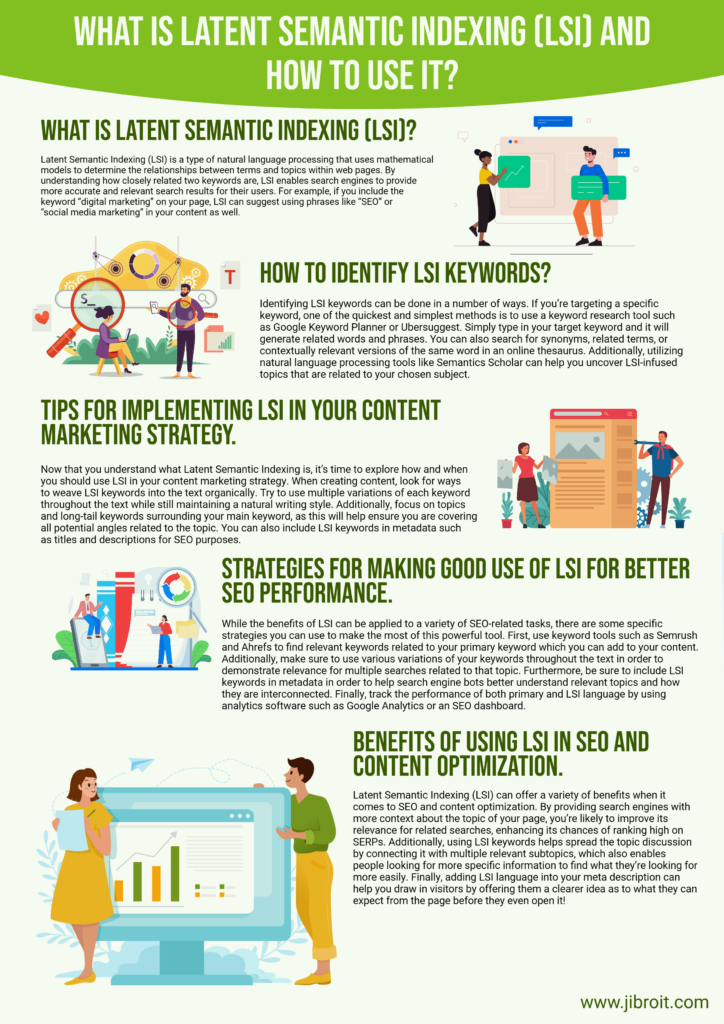Latent Semantic Indexing (LSI) is a powerful search engine optimization technique that helps you identify related terms and topics related to your main keyword. By understanding how these different terms are related, you can use LSI keywords to improve the visibility of your content and optimize it for higher ranking in search engine results pages.
What is Latent Semantic Indexing (LSI)?
Latent Semantic Indexing (LSI) is a type of natural language processing that uses mathematical models to determine the relationships between terms and topics within web pages. By understanding how closely related two keywords are, LSI enables search engines to provide more accurate and relevant search results for their users. For example, if you include the keyword “digital marketing” on your page, LSI can suggest using phrases like “SEO” or “social media marketing” in your content as well.
How to Identify LSI Keywords?
Identifying LSI keywords can be done in a number of ways. If you’re targeting a specific keyword, one of the quickest and simplest methods is to use a keyword research tool such as Google Keyword Planner or Ubersuggest. Simply type in your target keyword and it will generate related words and phrases. You can also search for synonyms, related terms, or contextually relevant versions of the same word in an online thesaurus. Additionally, utilizing natural language processing tools like Semantics Scholar can help you uncover LSI-infused topics that are related to your chosen subject.
Tips for Implementing LSI in Your Content Marketing Strategy.
Now that you understand what Latent Semantic Indexing is, it’s time to explore how and when you should use LSI in your content marketing strategy. When creating content, look for ways to weave LSI keywords into the text organically. Try to use multiple variations of each keyword throughout the text while still maintaining a natural writing style. Additionally, focus on topics and long-tail keywords surrounding your main keyword, as this will help ensure you are covering all potential angles related to the topic. You can also include LSI keywords in metadata such as titles and descriptions for SEO purposes.
Strategies for Making Good Use of LSI for Better SEO Performance.
While the benefits of LSI can be applied to a variety of SEO-related tasks, there are some specific strategies you can use to make the most of this powerful tool. First, use keyword tools such as Semrush and Ahrefs to find relevant keywords related to your primary keyword which you can add to your content. Additionally, make sure to use various variations of your keywords throughout the text in order to demonstrate relevance for multiple searches related to that topic. Furthermore, be sure to include LSI keywords in metadata in order to help search engine bots better understand relevant topics and how they are interconnected. Finally, track the performance of both primary and LSI language by using analytics software such as Google Analytics or an SEO dashboard.

Benefits of Using LSI in SEO and Content Optimization.
Latent Semantic Indexing (LSI) can offer a variety of benefits when it comes to SEO and content optimization. By providing search engines with more context about the topic of your page, you’re likely to improve its relevance for related searches, enhancing its chances of ranking high on SERPs. Additionally, using LSI keywords helps spread the topic discussion by connecting it with multiple relevant subtopics, which also enables people looking for more specific information to find what they’re looking for more easily. Finally, adding LSI language into your meta description can help you draw in visitors by offering them a clearer idea as to what they can expect from the page before they even open it!


